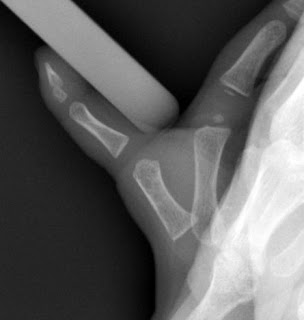The process of limb development is truly amazing and unbelievably complex. Developmental biologists and scientists help to explain these processes and our knowledge grows day by day. As I explain to parents, what is truly remarkable is not that there is a child born with a limb difference but rather that it happen so uncommonly. One such uncommon finding is a crooked finger, or for the purposes of this post, a crooked thumb.
In my experience, the most common cause of a crooked thumb is an extra bone which creates a triphalangeal thumb. I have previously written about the type of thumb HERE. Typically, there are two bones in the thumb but, like fingers, there can occasionally be three bones- the TRIphalangeal thumb. This can occur in association with an extra thumb (see HERE) or in isolation. Not every triphalangeal thumb is crooked– the alignment depends on the shape of the extra bone.
When the extra bone is triangular in shape, the thumb is crooked and can affect function. Typically, surgery to remove that bone (or straighten it) is performed. In doing so, the thumb is shortened as well. When the extra bone is more normally shaped- rectangular- then the thumb is not crooked and a decision for surgery is more complex. For some kids, the long thumb may not be a problem but for others, the length of the thumb + the extra joint can cause functional issues.
This 18- month old came to the office because of a crooked thumb. Mom had noticed some difficulty with pinching and decreased use of the thumb. Here are pictures and x-rays which demonstrate the deformity.
 |
| Crooked thumb related to an extra bone- a triphalangeal thumb. |
 |
| Crooked thumb related to an extra bone- a triphalangeal thumb. It is more difficult to see in this side- view picture. |
 |
| The extra bone can be seen in the x- ray causing the thumb to be crooked. |
 |
| The extra bone in this thumb is more difficult to see in this x- ray. |
Surgery to address the crooked thumb addresses the extra bone. A recent investigation carefully evaluated the best way to surgically treat this condition. The authors evaluated excision of the extra bone compared to angular correction and fusion of one of the joints- the results were similar. New Article.